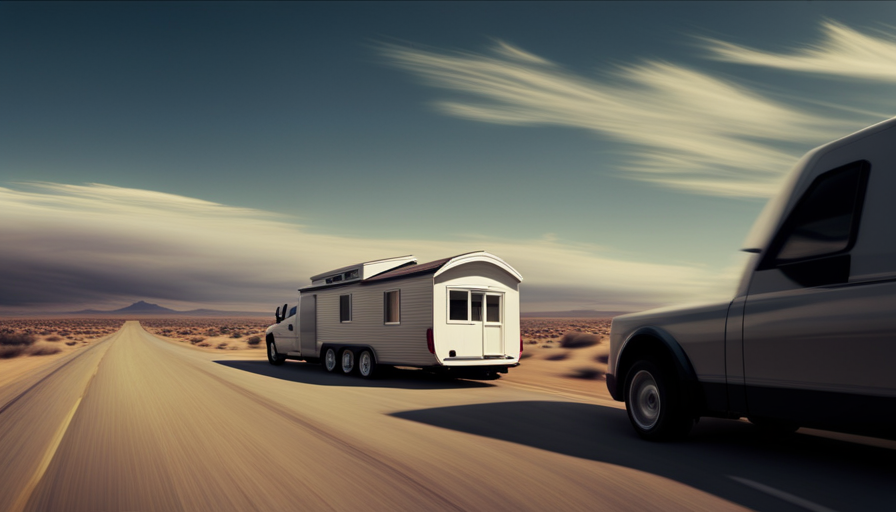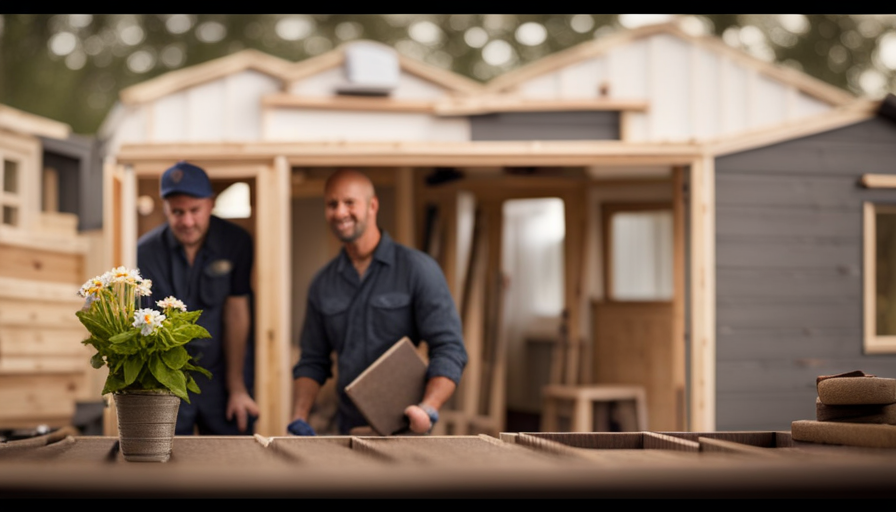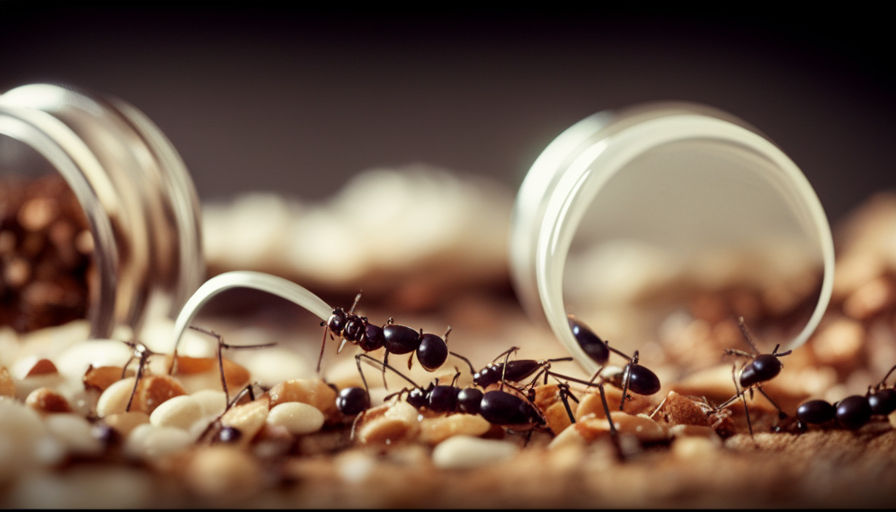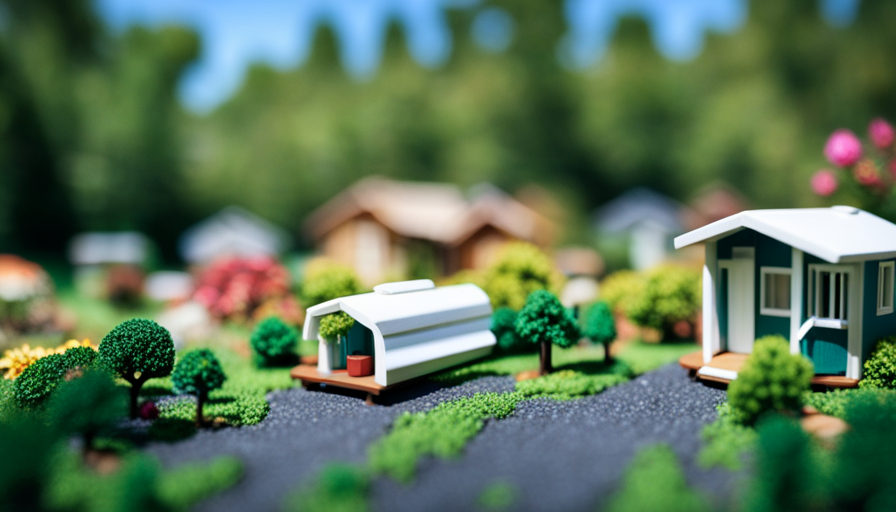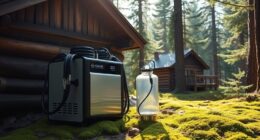Congratulations on deciding to join the small house movement and embrace a simpler, more eco-friendly lifestyle! Now, the next step is figuring out the best method to transport your tiny home from where it is now to its new location.
Sure, you could hire a professional moving company, but where’s the fun in that? Plus, who wants to spend all that money? No, my friend, you’re going to take matters into your own hands and haul that tiny house yourself.
But here’s the million-dollar question: how bog of a car do you actually need to get the job done? In this article, we’ll break down the factors you need to consider, from the weight of your tiny house to your vehicle’s towing capacity, so you can hit the road with confidence and embark on your tiny house adventure.
It’s time to unleash your inner road warrior!
Key Takeaways
- Determining the weight of the tiny house is crucial for choosing the right car for towing.
- Checking the towing capacity of the vehicle is essential to avoid safety issues and damage.
- Proper weight distribution is important for control and stability while towing.
- Understanding legal requirements and regulations for towing a tiny house is necessary, including permits and zoning restrictions.
Determine the Weight of Your Tiny House
If you’re wondering how big of a car you’ll need to haul your tiny house, the first step is to determine the weight of your tiny house.
Calculating the weight of your tiny house is crucial to ensure that your car can handle the load. There are a few key factors to consider when determining the weight of your tiny house.
First, you need to take into account the materials used in the construction of your tiny house. Different materials have different weights, so it’s important to be aware of the potential weight variations.
Additionally, the size of your tiny house will also affect its weight. Larger tiny houses will naturally weigh more than smaller ones.
Another important consideration is the trailer options available for your tiny house. Depending on the type of trailer you choose, the weight distribution may vary. It’s important to research and select a trailer that is suitable for the weight of your tiny house.
Once you have calculated the weight of your tiny house, you can then check your vehicle’s towing capacity to determine if it can handle the load. This will ensure a safe and smooth journey as you transport your tiny house to its new location.
Check Your Vehicle’s Towing Capacity
Make sure you know the towing capacity of your vehicle before you hit the road with your dream home in tow, or you could find yourself facing a major disappointment. To calculate your vehicle’s towing capacity, you need to evaluate its power and capabilities.
Start by checking your vehicle’s owner’s manual or contacting the manufacturer to find the specific towing capacity for your make and model. This information is crucial as exceeding your vehicle’s towing capacity can lead to serious safety issues and potential damage to your vehicle.
When evaluating your vehicle’s power, consider factors such as the engine size, transmission type, and axle ratio. These specifications will help determine how much weight your vehicle can safely tow. Additionally, you should take into account any additional equipment or modifications that may affect your vehicle’s towing capacity, such as towing packages or upgraded suspension systems.
Once you have determined your vehicle’s towing capacity, you can then consider the size and dimensions of your tiny house. This will help you ensure that your vehicle is not only capable of towing the weight but also accommodating the size and dimensions of your tiny house. Consider factors such as the overall length, width, and height of your tiny house, as well as any additional weight from furniture or appliances.
By carefully evaluating your vehicle’s towing capacity and considering the size and dimensions of your tiny house, you can confidently hit the road knowing that you have made the necessary preparations.
Consider the Size and Dimensions of Your Tiny House
When evaluating the size and dimensions of your dream home, be sure to consider how well it will fit and travel with you on the road. It’s not just about finding a car that can tow your tiny house; you also need to think about whether the house is suitable for road travel.
One important factor to consider is the terrain you’ll be traversing. If you plan on driving through hilly or mountainous areas, you’ll need a sturdy and powerful car that can handle the extra weight and navigate the challenging terrain.
Additionally, evaluating the structural integrity of your tiny house is crucial. The construction and materials used should be able to withstand the vibrations and movements during transportation. This will ensure that your home remains safe and intact throughout the journey.
Considering these factors will help you determine the size and weight limits for your towing vehicle. It’s important to find a car that can comfortably handle the weight of your tiny house while also providing a smooth and stable ride. By evaluating the size and dimensions of your tiny house and considering the terrain and structural integrity, you can make an informed decision about the type of car you need.
As you move forward, it’s essential to choose the right hitch and trailer for your vehicle, ensuring a secure connection between your car and tiny house.
Choose the Right Hitch and Trailer for Your Vehicle
Consider hitching your dreams to a sturdy and reliable companion, ensuring a seamless connection between your wanderlust and the open road. When it comes to choosing the right hitch and trailer for your vehicle, there are a few important factors to consider.
First, you’ll want to make sure that the hitch installation is done correctly and securely. This will ensure that your tiny house stays firmly attached to your vehicle, providing a safe and stable towing experience.
Next, it’s crucial to pay attention to trailer weight distribution techniques. Proper weight distribution is essential for maintaining control and stability while towing. You’ll want to make sure that the weight of your tiny house is evenly distributed across the trailer, avoiding any excessive weight on one side. This can be achieved by adjusting the placement of heavy items and using weight distribution hitches if necessary.
By choosing the right hitch and trailer for your vehicle, and ensuring proper weight distribution and balance, you can have peace of mind knowing that your tiny house will be safely and securely towed. This will allow you to embark on your adventures with confidence, knowing that you have made the necessary preparations for a smooth and enjoyable journey.
Ensure Proper Weight Distribution and Balance
To ensure a smooth and enjoyable journey, it’s important to achieve proper weight distribution and balance when towing your dream home on wheels. Weight distribution refers to the way the weight is distributed between the tow vehicle and the trailer. It is crucial to have a balanced load to prevent swaying, instability, and potential accidents on the road.
One key factor to consider is the towing capacity of your vehicle. This refers to the maximum weight that your vehicle can safely tow. Exceeding this limit can put undue stress on your vehicle’s engine, transmission, and brakes, leading to potential damage. It’s important to consult your vehicle’s manual or contact the manufacturer to determine the exact towing capacity.
Once you know the towing capacity, you can calculate the weight distribution to ensure optimal balance. The weight should be evenly distributed between the front and rear axles of both the tow vehicle and the trailer. This can be achieved by properly loading the trailer, placing heavy items towards the center and distributing weight evenly from side to side.
Understanding the legal requirements and regulations for towing a tiny house is also essential. By adhering to these guidelines, you can ensure a safe and legal journey.
Now, let’s delve into the next section and explore the legal requirements and regulations for towing your tiny house.
Understand the Legal Requirements and Regulations
Understanding the legal requirements and regulations is crucial in ensuring a safe and compliant towing experience for your mobile home. When it comes to hauling a tiny house, there are certain permits and zoning restrictions that need to be considered. Before embarking on your journey, it’s important to research and obtain any necessary permits from local authorities.
Additionally, be aware of any zoning restrictions that may limit where you can park or set up your tiny house. Insurance requirements are another aspect to consider when towing a tiny house. It’s essential to have the proper insurance coverage to protect yourself and your investment. Check with your insurance provider to ensure that you have adequate coverage for towing a mobile home.
To emphasize the importance of understanding the legal requirements and regulations, here are a few key points to consider:
- Obtain necessary permits from local authorities.
- Research and comply with any zoning restrictions.
- Ensure you have the proper insurance coverage.
- Familiarize yourself with any weight or size restrictions.
- Adhere to any specific towing regulations in your area.
By understanding and following these legal requirements and regulations, you can ensure a smooth and hassle-free towing experience for your tiny house. As you plan your route and consider road conditions, keep in mind the importance of adhering to the rules and regulations discussed above.
Plan Your Route and Consider Road Conditions
Navigating the winding roads and unpredictable conditions ahead, I carefully strategize my route and account for road conditions when towing my beloved mobile abode.
Route planning is crucial to ensure a smooth journey and avoid any unnecessary obstacles. Before hitting the road, I meticulously study maps and GPS systems to identify the most suitable route for hauling my tiny house. I consider factors such as road width, bridge height, weight restrictions, and any potential hazards along the way.
Road conditions play a significant role in determining the type of car I need to haul my tiny house. I assess the condition of roads, including their surface quality, steep inclines, tight turns, and potential weather-related challenges. A sturdy and powerful car is essential to navigate through rough terrains and overcome any unexpected road conditions.
To prepare for potential challenges and obstacles, I equip my car with the appropriate tires and suspension system to handle varying road conditions. Additionally, I keep an eye on weather forecasts and adjust my route accordingly to avoid adverse weather conditions. Being proactive in planning and adapting to road conditions ensures a safe and hassle-free towing experience.
Transitioning into the next section about preparing for potential challenges and obstacles, it is crucial to anticipate any unforeseen circumstances that may arise during the journey. By taking necessary precautions and staying vigilant, I can overcome any challenges that come my way while towing my tiny house.
Prepare for Potential Challenges and Obstacles
When it comes to hauling a tiny house, there are several potential challenges and obstacles that you need to be aware of.
One of the first considerations is determining the weight of your tiny house and comparing it to the towing capacity of your car. It’s crucial to ensure that your car is capable of safely towing the weight of your tiny house.
Size considerations also come into play when it comes to hauling a tiny house. You need to consider the dimensions of your tiny house and how it will fit on your car’s hitch. Selecting the right hitch is essential to ensure a secure connection between your car and the tiny house.
Weight distribution is another critical factor to take into account. Properly distributing the weight of your tiny house on the hitch is crucial for safe towing. It’s also important to be aware of any legal requirements for towing a tiny house, such as permits or specific regulations based on your location.
Route planning is essential to ensure a smooth journey. You need to consider the potential challenges of the route, such as narrow roads or steep inclines, and plan accordingly.
If you’re not experienced in towing, it’s highly recommended to seek professional assistance. They can provide valuable guidance and ensure that you’re following safe towing techniques. Remember, practice safe towing techniques and drive with caution to ensure a successful journey to your destination.
Practice Safe Towing Techniques and Drive with Caution
Stay vigilant on the road, making sure to securely connect your dreams to the open highway as you embark on your journey towards a new chapter of freedom and independence.
When it comes to towing a tiny house, practicing safe driving and employing proper towing techniques is crucial. It’s important to remember that you’re not just hauling a heavy load; you’re also responsible for the safety of yourself and others on the road.
To ensure safe towing, start by familiarizing yourself with the weight limits and towing capacity of your vehicle. This information can usually be found in the owner’s manual or by consulting with a professional. Additionally, make sure to distribute the weight of your tiny house evenly, placing heavier items towards the front and securing everything tightly to minimize shifting during transit.
When driving, maintain a safe and steady speed, keeping in mind that your vehicle’s acceleration, braking, and turning capabilities may be affected by the added weight. Be cautious of your surroundings and give yourself extra time and space to maneuver. Keep a safe distance from other vehicles and avoid sudden movements that could cause instability.
Safe driving and proper towing techniques are essential when hauling a tiny house. By being mindful of weight limits, distributing weight evenly, and driving with caution, you can ensure a smooth and secure journey. Remember, it’s better to seek professional assistance if needed rather than risking the safety of yourself and others on the road.
Seek Professional Assistance if Needed
If you’re unsure or overwhelmed, don’t hesitate to seek professional help when towing your tiny house. Seeking professional advice can provide you with the necessary expertise and guidance to ensure a safe and successful towing experience.
Professionals who specialize in towing can assess your specific needs and recommend the appropriate equipment and vehicle for your tiny house.
When seeking professional assistance, it’s important to consider any additional expenses that may arise. Towing professionals have the knowledge and experience to determine the best route for your journey, taking into account factors such as road conditions, weight limits, and potential obstacles. They can also provide valuable insight on the legal requirements and permits needed for towing a tiny house.
Engaging the services of a professional can save you time, money, and stress. They can help you avoid costly mistakes and ensure that your tiny house arrives at its destination safely. By entrusting the towing process to experts, you can focus on other aspects of your move and have peace of mind knowing that your tiny house is in good hands.
Seeking professional assistance when towing your tiny house is a smart decision that can mitigate risks and ensure a smooth and successful journey. So, don’t hesitate to reach out to towing professionals who can help you assess your needs and provide the necessary expertise for a safe and efficient towing experience.
Frequently Asked Questions
What type of vehicle is best for towing a tiny house?
When it comes to towing a tiny house, it’s crucial to choose the right vehicle. According to a recent study, the best towing vehicles for tiny houses are typically large trucks or SUVs with high towing capacities. These vehicles provide the necessary power and stability to safely tow your tiny house.
To ensure safe towing, here are some tips: check your vehicle’s towing capacity, distribute the weight evenly, use proper towing equipment, and practice safe driving techniques.
How do I determine the weight of my tiny house?
To determine the weight of your tiny house, start by calculating the weight distribution of your belongings inside. This will help you distribute the weight evenly and ensure safe towing.
Next, you’ll need to find out the towing capacity of your vehicle. Consult the manufacturer’s guidelines or consult a professional to determine the maximum weight your car can safely tow. This information will help you choose the appropriate car for hauling your tiny house.
Are there any legal requirements or regulations for towing a tiny house?
There are legal requirements and regulations for towing a tiny house. It’s important to research and understand these rules before attempting to tow your tiny house. The specific requirements can vary depending on your location. Common regulations include having a valid driver’s license, ensuring your tow vehicle is properly equipped and rated to tow the weight of your tiny house, and following any size or height restrictions set by your local transportation department.
How do I choose the right hitch and trailer for my vehicle?
To choose the right hitch and trailer for my vehicle, I need to consider the hitch installation process and the different types of trailers available.
First, I should ensure that my vehicle is capable of towing the weight of the trailer and the tiny house. Then, I can research different hitch options that are compatible with my vehicle.
Finally, I should explore the various types of trailers, such as flatbed, utility, or enclosed, to determine which one suits my needs best.
What are some potential challenges or obstacles I may encounter when towing a tiny house?
When towing a tiny house, there are several potential challenges that may arise. Firstly, the weight of the tiny house can significantly affect the stability and handling of the towing vehicle.
Additionally, maneuvering and parking in tight spaces can be difficult due to the increased length and width of the trailer. It’s crucial to take safety precautions such as ensuring proper weight distribution, using sway control devices, and regularly checking tire pressure and brakes to mitigate these challenges and ensure a safe towing experience.
Conclusion
Well, it turns out that hauling a tiny house requires a lot more than just any old car. Who would have thought?
You need to consider the weight of your tiny house, your vehicle’s towing capacity, and even the size and dimensions of your tiny house. And don’t forget about choosing the right hitch and trailer, ensuring proper weight distribution, and planning your route.
It’s not as simple as it seems, but with some careful planning and safe driving techniques, you’ll be on your way to tiny house towing success.
Hi, I’m Emma. I’m the Editor in Chief of Tiny House 43, a blog all about tiny houses. While tree houses are often associated with childhood, they can be the perfect adult retreat. They offer a cozy space to relax and unwind, surrounded by nature. And since they’re typically built on stilts or raised platforms, they offer stunning views that traditional homes simply can’t match. If you’re looking for a unique and romantic getaway, a tree house tiny house might just be the perfect option.

